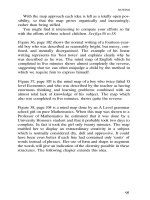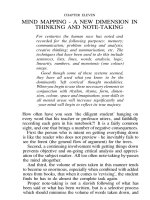tony buzan mind maps and making notes phần 1 pps
Bạn đang xem bản rút gọn của tài liệu. Xem và tải ngay bản đầy đủ của tài liệu tại đây (219.08 KB, 11 trang )
CHAPTER ELEVEN
MIND MAPPING - A NEW DIMENSION IN
THINKING AND NOTE-TAKING
For centuries the human race has noted and
recorded for the following purposes: memory;
communication; problem solving and analysis;
creative thinking; and summarisation, etc. The
techniques that have been used to do this include
sentences, lists, lines, words, analysis, logic,
linearity, numbers, and monotonic (one colour)
usage.
Good though some of these systems seemed,
they have all used what you know to be the
dominantly 'left cortical' thought modalities.
When you begin to use these necessary elements in
conjunction with rhythm, rhyme, form, dimen-
sion, colour, space and imagination, your skills in
all mental areas will increase significantly and
your mind will begin to reflect its true majesty.
How often have you seen 'the diligent student' hanging on
every word that his teacher or professor utters, and faithfully
recording each gem in his notebook?! It is a fairly common
sight, and one that brings a number of negative consequences.
First the person who is intent on getting everything down
is like the reader who does not preview - he inevitably fails to
see the forest (the general flow of argument) for the trees.
Second, a continuing involvement with getting things down
prevents objective and on-going critical analysis and appreci-
ation of the subject matter. All too often note-taking by-passes
the mind altogether.
And third, the volume of notes taken in this manner tends
to become so enormous, especially when combined with added
notes from books, that when it comes to 'revising', the student
finds he has to do almost the complete task again.
Proper note-taking is not a slavish following of what has
been said or what has been written, but is a selective process
which should minimise the volume of words taken down, and
maximise the amount remembered from those words.
To achieve this we make use of the 'Key-Word' concept. A
Key-Word is a word that encapsulates a multitude of
meanings in as small a unit as possible. When that word is
triggered, the meanings spray free. It can be effectively
represented by the diagram below.
Selecting Key-Words is not difficult. The first stage is to
eliminate all the unnecessary surrounding language, so that if
you came across the following statement in a science text: 'the
speed of light has now been determined to be 186,000 miles
per second' you would not write the whole sentence down but
would summarise it as follows: 'light's speed = 186,000
m.p.s.'.
It is important to remember when making your notes with
key-words that the Key-Words must trigger the right kind of
remembering. In this respect words like 'beautiful', and
'horrifying', while being picturesque, are too general. They
have many other meanings which might have nothing to do
with the particular point you wish to remember.
KEY-WORD
Fig. 9 How key-words work in assisting note-taking and memory
Further, a Key-Word should be one that you find person-
ally satisfying and not one which you think somebody else
might think is good. In many cases Key-Words need not be
taken directly from the content of the lecture or the material
being read. A word that you choose yourself and which
summarises somebody else's words, is preferable.
If you practise Key-Word note-taking effectively you will
be amazed at how much more information you can get into a
given space.
INFORMATION
FUNNELLED IN
SPRAYED OUT
The Mind Map — A New Dimension in Note-Taking
A Mind Map draws on all your mental skills: the Associative
and Imagination skills from your memory; the words,
numbers, lists, sequences, logic and analysis from your left
cortex; the colour, imagery, dimension, rhythm, day-dream-
ing, Gestalt (whole picture) and spacial awareness abilities of
the right side of your cortex; the power of your eye to perceive
and assimilate; the power of your hand, with increasing skill,
to duplicate what your eye has seen; and the power of your
whole brain to organise, store, and recall that which it has
learnt.
In Mind Map notes, instead of taking down what you wish
to remember in the normal sentence or list-like fashion, you
place an image in the centre of your note page (to help your
concentration and memory) and then branch out in an
organised fashion around that image, using Key-Words and
Key Images. As you continue to build up the Mind Map, your
brain creates an organised and integrated total map of the
intellectual territory you are exploring.
The rules for a Mind Map are as follows:
1. A coloured image in the centre.
2. Main ideas branch off the centre.
3. Main ideas should be in larger letters than secondary
ideas.
4. Words - always one word per line. Each word has an
enormous number of associations, and this rule allows
each one more freedom to link to other associations in
your brain.
5. Words should always be printed (either upper or lower,
or a combination of upper and lower cases).
6. Words should always be printed on the lines (this gives
your brain a clearer image to remember).
7. Lines should be connected (this helps your memory to
associate). The connected lines should be the same length
as the word for efficiency of both association and space.
8. Use as many images as possible (this helps develop a
whole-brained approach, as well as making it much easier
for your memory; a picture is, in this context, worth a
thousand words).
9. Use dimension wherever possible (things outstanding are
108
Fig 10 A Mind Map by a company director, summarising the Brain Training and Mind Mapping Course. The central image
refers to the integration of the brain and the body. The branches off the central image summarise the major elements of the
course Images, rather than words, provide succinct memory aids. This Mind Map was used both as a summary and review
tool It was also used as a means of presenting to other members of the company what had been gained during the course.
more easily remembered).
10. Use numbers or codes or put things in order, or show
connections.
11. For coding and connecting use:
a. Arrows
b. Symbols
c. Numbers
d. Letters
e. Images
f. Colours
g. Dimension
h. Outlining
On page 109 is a Mind Map summarising a three-day Brain
Training and Mind Mapping Course. The Mind Map was
made by a father who was also a company director. He used
the same Mind Map to summarise the course for himself, and
to explain the course to his wife, children and business
colleagues.
The central image refers to the integration of the brain and
the body. The branches, clockwise from 'exercises' at 9
o'clock, summarise the major elements of the course.
Images, rather than words, provide succinct memory aids.
The Mind Map note of this three day course, as you can
see, can be useful not only as a noted summary of all that was
dealt with, but could also be used as the notes for the speech
itself.
In this situation the Mind Map becomes the 'note from your
own brain' which then allows you to communicate to others,
thus completing the Speed and Range Reading cycle.
As an interesting exercise in the power of the Mind Map
technique, try 'reading' in detail the Mind Map on the Brain
Training and Mind Mapping Course, to see how comprehen-
sive a summary/understanding you can obtain from this one
page note.
Now that you have learnt the Mind Mapping technique, it
will be useful for you to go back over the Self Tests in
Chapters 1, 3, 7, 9 and 10. Continue to extract the Key-Words
from them, and to make Mind Maps of each essay. In this
way you will be reviewing your speed reading skills, develop-
ing your note taking and Mind Mapping skills, and establish-
110
ing basic knowledge foundations in the fields of the brain,
psychology, science, history and music.
As you continue through Speed Reading, make it a practice,
after you have tested yourself on the Self Tests, to review
them, underlining key words and concepts, and subsequently
to Mind Map each article.
As a matter of interest finish this day's reading by thumbing
through some of your old notes from school or other sources,
observing how much was completely unnecessary, and how
much time you could have saved first in writing them down,
and second in reading them back. Many people find that only
as little as 10% was necessary.
For a full explanation of the Mind Mapping Technique see
Use Your Head by the author.
III
Personal Notes
70
4.
Noting
A: Key words
Overview
• Exercise key words; standard responses
• Key words and concepts - creative and recall
• Memory - a comparison between
standard note and
key word noting
• Transition from advanced key word
note taking to advanced Mind Map
key word note taking
71
Exercise and discussion
Imagine that your hobby is reading short stories, that you read at
least five a day, and that you keep notes so that you will not forget
any of them. Imagine also that in order to ensure a proper recall
of each story you use a card filing system. For each story you
have one card for the title and author, and a card for every para-
graph. On each of these paragraph cards you enter a main and a
secondary key word or phrase. The key words/phrases you take
either directly from the story or make up yourself because they
summarise particularly well.
Imagine further that your ten thousandth story is Kusa-Hibari by
Lafcadio Hearne, and that you have prepared the title-and-
author card.
Now read the story on page 73, and for the purpose of this ex-
ercise enter a key recall word or phrase for both the main and
secondary idea for the first five paragraphs only, in the space
provided on page 76.
72
NOTING
Kusa-Hibari Lafcadio Hearne
His cage is exactly two Japanese inches high and one inch and a
half wide: its tiny wooden door, turning upon a pivot, will
scarcely admit the tip of my little finger. But he has plenty of
room in that cage - room to walk, and jump, and fly, for he is so
small that you must look very carefully through the brown-gauze
sides of it in order to catch a glimpse of him. I have always to
turn the cage round and round, several times, in a good light,
before I can discover his whereabouts, and then I usually find
him resting in one of the upper corners - clinging, upside down,
to his ceiling of gauze.
Imagine a cricket about the size of an ordinary mosquito -
with a pair of antennae much longer than his own body, and so
fine that you can distinguish them only against the light.
Kusa-Hibari, or 'Grass-Lark' is the Japanese name of him; and
he is worth in the market exactly twelve cents: that is to say, very
much more than his weight in gold. Twelve cents for such a
gnat-like thing! By day he sleeps or meditates, except while
occupied with the slice of fresh egg-plant or cucumber which
must be poked into his cage every morning to keep him clean
and well fed is somewhat troublesome: could you see him, you
would think it absurd to take any pains for the sake of a creature
so ridiculously small.
But always at sunset the infinitesimal soul of him awakens:
then the room begins to fill with a delicate and ghostly music of
indescribable sweetness - a thin, silvery rippling and trilling as of
tiniest electric bells. As the darkness deepens, the sound
becomes sweeter - sometimes swelling till the whole house
seems to vibrate with the elfish resonance - sometimes thinning
down into the faintest imaginable thread of a voice. But loud or
low, it keeps a penetrating quality that is weird All night the
atomy thus sings: he ceases only when the temple bell proclaims
the hour of dawn.
Now this tiny song is a song of love - vague love of the unseen
and unknown. It is quite impossible that he should ever have
seen or known, in this present existence of his. Not even his
ancestors, for many generations back, could have known
anything of the night-life of the fields, or the amorous Value of
song.
73
They were born of eggs hatched in a jar of clay, in the shop of
some insect-merchant: and they dwelt thereafter only in cages.
But he sings the song of his race as it was sung a myriad years
ago, and as faultlessly as if he understood the exact significance
of every note. Of course he did not learn the song. It is a song of
organic memory - deep, dim memory of other quintillions of
lives, when the ghost of him shrilled at night from the dewy
grasses of the hills. Then that song brought him love - and death.
He has forgotten all about death: but he remembers the love.
And therefore he sings now - for the bride that will never come.
So that his longing is unconsciously retrospective: he cries to
the dust of the past - he calls to the silence and the gods for the
return of time Human lovers do very much the same thing
without knowing it. They call their illusion an Ideal: and their
Ideal is, after all, a mere shadowing of race-experience, a
phantom of organic memory. The living present has very little to
do with it Perhaps this atom also has an ideal, or at least the
rudiment of an ideal; but, in any event, the tiny desire must utter
its plaint in vain.
The fault is not altogether mine. I had been warned that if the
creature were mated, he would cease to sing and would speedily
die. But, night after night, the plaintive, sweet, unanswered
trilling touched me like a reproach - became at last an obsession,
an afflication, a torment of conscience; and I tried to buy a
female. It was too late in the season; there were no more
kusa-hibari for sale, - either males or females. The
insect-merchant laughed and said, 'He ought to have died about
the twentieth day of the ninth month.' (It was already the second
day of the tenth month.) But the insect-merchant did not know
that I have a good stove in my study, and keep the temperature at
above 75°F. Wherefore my grass-lark still sings at the close of the
eleventh month, and I hope to keep him alive until the Period of
Greatest Cold. However, the rest of his generation are probably
dead: neither for love nor money could I now find him a mate.
And were I to set him free in order that he might make the
search for himself, he could not possibly live through a single
night, even if fortunate enough to escape by day the multitude of
his natural enemies in the garden - ants, centipedes, and ghastly
earth-spiders.
74









